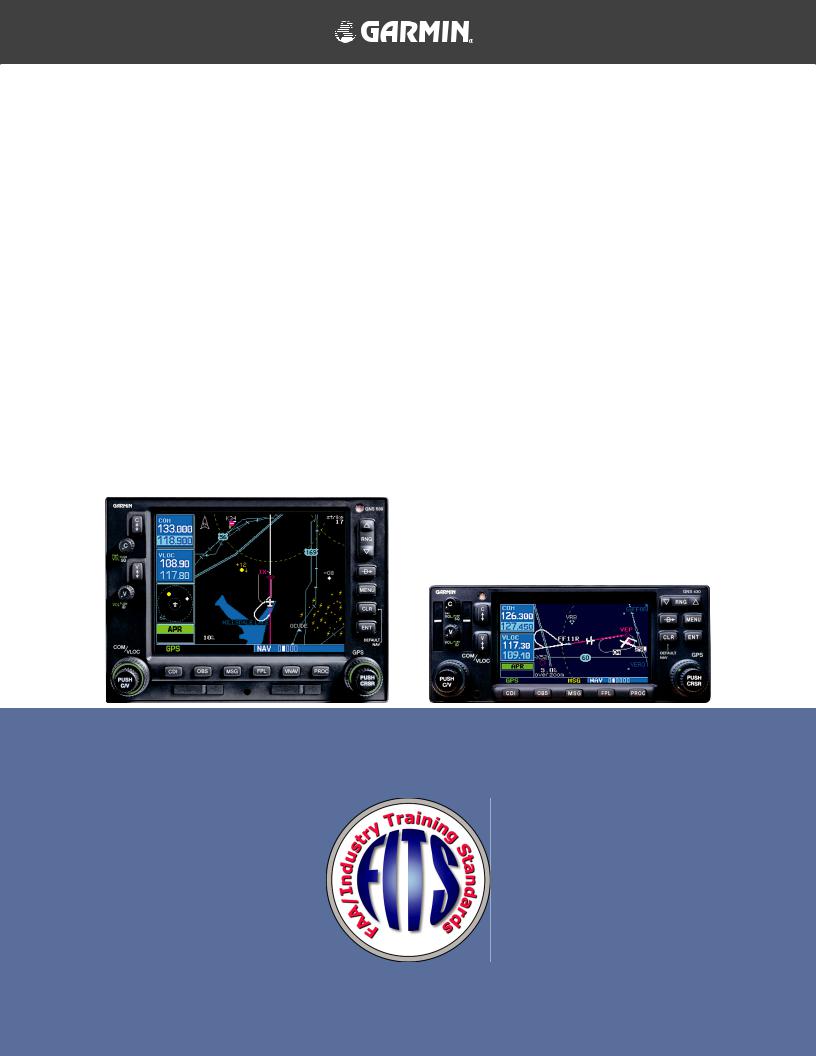Garmin GNS 530, GNS 430 Training Syllabus

Garmin GNS 530/430
Sample Training Syllabus
and Flight Lessons
for Use by
Flight Schools & Flying Clubs

Garmin GNS 530/430 SampleTraining Syllabus and Flight Lessons |
190-00334-00 Rev.A |

COPYRIGHT
© 2003 Garmin Ltd. or its subsidiaries. All rights reserved.
Garmin International, Inc., 1200 East 151st Street, Olathe, Kansas 66062, U.S.A.
Tel: 913/397.8200 |
Fax: 913/397.8282 |
Garmin AT, Inc., 2345 Turner Road SE, Salem, Oregon 97302, U.S.A. |
|
Tel: 503.391.3411 |
Fax 503.364.2138 |
Garmin (Europe) Ltd., Unit 5, The Quadrangle, Abbey Park Industrial Estate, Romsey, Hampshire S051 9DL, U.K. |
|
Tel: 44/1794.519944 |
Fax: 44/1794.519222 |
Garmin Corporation, No. 68, Jangshu 2nd Road, Shijr, Taipei County, Taiwan |
|
Tel: 886/02.2642.9199 |
Fax: 886/02.2642.9099 |
Web Site Address: www.garmin.com
Except as expressly provided herein, no part of this manual may be reproduced, copied, transmitted, disseminated, downloaded or stored in any storage medium, for any purpose without the express written permission of Garmin. Garmin hereby grants permission to download a single copy of this manual and of any revision to this manual onto a hard drive or other electronic storage medium to be viewed for personal use, provided that such electronic or printed copy of this manual or revision must contain the complete text of this copyright notice and provided further that any unauthorized commercial distribution of this manual or any revision hereto is strictly prohibited.
Information in this document is subject to change without notice. Garmin reserves the right to change or improve their products and to make changes in the content of this material without obligation to notify any person or organization of such changes or improvements.
Garmin® is a registered trademark of Garmin Ltd. or its subsidiaries and GNS™ is a trademark of Garmin Ltd. or its subsidiaries. These trademarks may not be used without the express permission of Garmin.
September 2003 |
Printed in the U.S.A. |
190-00334-00 Rev.A |
Garmin GNS 530/430 SampleTraining Syllabus and Flight Lessons |
i |

TABLE OF CONTENTS |
|
Copyright .......................................................................................................................... |
i |
Table of Contents ............................................................................................................ |
ii |
Introduction..................................................................................................................... |
1 |
Overview |
|
Home Study Worksheets................................................................................................. |
2 |
GNS 530/430 Home Study 1............................................................................................................ |
3 |
Worksheet – Use of GPS in lieu of other avionics, regulations |
|
GNS 530/430 Home Study 2............................................................................................................ |
4 |
Worksheet –Terminology Review |
|
GNS 530/430 Home Study 3............................................................................................................ |
5 |
Worksheet – COM andVLOC Operation |
|
GNS 530/430 Home Study 4............................................................................................................ |
6 |
Worksheet – Direct-to and Flight Plan Navigation |
|
GNS 530/430 Home Study 5............................................................................................................ |
7 |
Worksheet –Arrival, Departure andApproach Procedure Operation |
|
GNS 530/430 Home Study 6............................................................................................................ |
8 |
Worksheet – GNS 530/430 Series Display Interfaces;TIS |
|
GNS 530/430 Home Study 7............................................................................................................ |
9 |
Worksheet – GNS 530/430 Series Display Interfaces; GDL 49Weather |
|
GNS 530/430 Home Study 8.......................................................................................................... |
10 |
The Role ofAvionics inAeronautical Decision Making and Single-Pilot Resource Management |
|
GNS 530/430 Flight Orientation ................................................................................... |
12 |
Lesson 1: GNS 530/430 Introduction - Cross-Country Flight ..................................................... |
13 |
Lesson 2: Local Operational Flight Review................................................................................. |
14 |
Lesson 3: GNS 530/430 Dual Installation Introduction.............................................................. |
15 |
Lesson 4: Dual Installation MFD Operations.............................................................................. |
16 |
ii |
Garmin GNS 530/430 SampleTraining Syllabus and Flight Lessons |
190-00334-00 Rev.A |

INTRODUCTION
In flight schools, flying clubs and aircraft rental organizations, pilots are often required to learn how to operate the various types and makes of avionics installed in the rental fleet. In most cases, no specific training is provided on this equipment other than for rudimentary operation and minimum functions; in some cases no training is provided at all.
In modern aircraft, a number of new navigation techniques and pieces of equipment are available that are designed to enhance the safety of flight operations in visual and instrument meteorological conditions. Advances in navigation technology can provide the greatest benefits in situational awareness and help reduce the cost of flight operations by allowing more direct routes and simplified approach procedures.
Of all of these advances, none of them alone can bring about a major change in the accident rate of general aviation aircraft. Pilot training and periodic evaluation is the key to realizing the safety benefits of new technology and reducing accident rates. The combination of technology and pilot training will help increase safety, lower insurance costs and improve the public perception of general aviation.
Overview
The enclosed sample syllabi and lesson plans are provided as part of the FAA – Industry Training Standards program (FITS). This information is designed to be incorporated into existing flight training/aircraft checkout/recurrent qualification programs.
The syllabi and lesson plans are valid for both GNS 530 and GNS 430 series Garmin avionics. There are 3 main training types that this material may be used for: home study, flight checkout and recurrent.
The home study portion is designed to prepare the pilot for use of the avionics and to maximize the flight training segment that follows. This part of the materials is for use with any pilot who plans to fly aircraft equipped with GNS 530/430 avionics. It can be incorporated in any stage of pilot training, including private pilot, instrument and commercial as well as aircraft checkouts and recurrent training, instrument proficiency checks (IPCs), and flight reviews.
The flight training segments emphasize scenario-based training. These flights are designed to be cross-country flights resembling normal flight operations. The en-route segment is ideal for standard air work and provides an opportunity to train a pilot in both VFR and simulated IFR conditions quickly. It challenges the pilot’s ability to respond to a suddenly increased workload while testing his or her ability to properly use the avionics systems.
The recurrent training portion uses the same sample enclosed materials for use in conjunction with insurance qualifications, IPCs, or flight reviews and is equally well suited for each. The structure remains the same and is based around the home study review of the avionics in preparation for the flight segment. It encourages use of all system capabilities which, depending on the pilot’s typical flight operations, may not be used in the normal course of the flight.
These lessons are only sample lesson plans and are designed to be used in conjunction with other programs. Suggestions and recommendations are welcome and will be taken into consideration in future document revisions. Comments/ suggestions can be sent via e-mail to the Garmin FITS Program Manager at: CFI_Tools@garmin.com.
IDisclaimer:
These documents are samples only and are provided solely as tools to help Certified Flight Instructors develop their own training programs. It is also the sole responsibility of the CFI and pilot in training to ensure that training is completed to an appropriate level of proficiency.
190-00334-00 Rev.A |
Garmin GNS 530/430 SampleTraining Syllabus and Flight Lessons |
1 |

HOME STUDY
Home Study Worksheets
Objective:
To develop a basic level of knowledge surrounding the operation of Garmin GNS 530/430 avionics prior to the commencement of actual flight training.
Elements:
•Terminology Review
•Review of requirements for the use of GPS in lieu of other avionics equipment
•Communications radio operation
•VOR/LOC (VLOC) operation
•GPS operation
•Additional interfaces and associated operations
•Avionics use as an aid to the aeronautical decision making process
•PC simulator exercises
Schedule:
Each lesson is designed to take approximately 1 to 2 hours.
Equipment:
•GNS 530/430 Pilot’s Guides and Quick References
•GNS 530/430 Interface Addendum
•GNS 530/430 PC simulator
•Lessons
•Worksheets
Student Actions:
Complete all lessons prior to arriving for training/checkout flight(s).
Completion Standards:
Satisfactory completion of all worksheets/lessons prior to flight training as determined by instructor.
2 |
Garmin GNS 530/430 SampleTraining Syllabus and Flight Lessons |
190-00334-00 Rev.A |

HOME STUDY
GNS 530/430 Home Study 1
Worksheet – Use of GPS in lieu of other avionics, regulations
After reviewing AIM section 1-1-21 f. (Use of GPS for IFR Oceanic, Domestic En Route, and Terminal Area Operations), answer the following questions:
1.In general, can the GNS 430 or GNS 530 be used for IFR operations in place of ADF and/or DME equipment?
2.Describe the requirements for determining aircraft position over a DME fix using GPS.
3.Describe the requirements for flying a DME arc using GPS.
4.Describe the requirements for holding over an NDB/compass locator using GPS.
5.Must the Jeppesen navigation database be current to fly approaches under IFR?
6.What does the abbreviation RAIM stand for?
7.For preflight preparation, how can you obtain GPS RAIM information?
8.While flying an approach, what should the pilot do if a RAIM warning is received prior to arrival at the Final Approach Waypoint?
9.Explain the difference between fly-over and fly-by waypoints and draw a picture of their approach chart symbols.
10.On some approaches, the heading information portrayed on the GPS is slightly different than the heading shown on the chart; why does this happen?
190-00334-00 Rev.A |
Garmin GNS 530/430 SampleTraining Syllabus and Flight Lessons |
3 |
